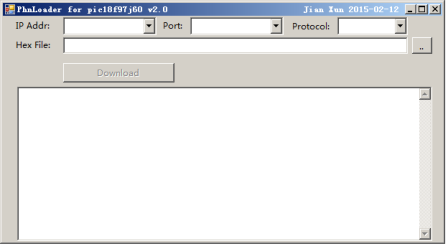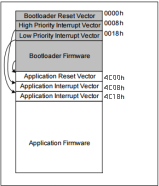采用TCP协议实现PIC18F97J60 ethernet bootloader
了解更多关于bootloader 的C语言实现,请加我Q扣: 1273623966 (验证信息请填 bootloader),欢迎咨询或定制bootloader(在线升级程序)。
TCP/IP Stack
Microchip TCP/IP Stack是免费的,广泛应用于PIC单片机中。由于有远程更新程序的需求,我决定开发基于TCP协议的ethernet bootloader, 主要使用了Microchip TCP/IP Stack的TCP模块。最终我开发出来的ethernet bootloader 在PIC18F97J60上验证通过。整个实现上分两部分,一部分是单片机端的基于TCP协议的bootloader程序,我将其命名为PhnBoot_v2.0, 另外一部分是同样基于TCP协议与单片机互动的PC端通信程序,我将其命名为PhnLoader_v2.0。我还定义了PhnBoot_v2.0和PhnLoader_v2.0之间传输数据的通信协定。下面将细说我是如何实现的。
通信协定
单片机端PhnBoot_v2.0和PC端PhnLoader_v2.0之间的通信数据包采用以下协定
<STX><CMD><ADDRL><ADDRH><ADDRU><LEN><DATA>...<DATA><ETX>
定义如下:
STX - Start of packet indicator
ETX - End of packet indicator
LEN - The length of true data
DATA - General data 16 bytes, only first LEN of datas are true
CMD - Base command
ADDR - Address up to 24 bits ( ADDRL , ADDRH , ADDRH)
具体有以下Base command:
RD-VER: 0x00 -- Read Version Information (最终版本删除了此命令)
RD_MEM: 0x01 -- Read Program Memory (最终版本删除了此命令)
ER_MEM: 0x03 -- Erase Program Memory
WR_MEM: 0x02 -- Write Program Memory
WR_CFG: 0x04 -- Write Configuration Registers
PhnLoader_v2.0 功能
定义好了通讯协定, 接着就按照协定去实现PhnLoader_v2.0。 PhnLoader_v2.0的具体功能包括选择IP地址,端口和协议类型, 目前只支持TCP协议, 创建TCP服务器,加载应用程序Hex文件,Parse 应用程序的Hex文件,一行一行解读Hex文件,一旦收到连接请求,建立TCP连接,一旦收到应用程序更新请求,立刻按照通讯协定采用TCP协议发送Hex记录到单片机,接收单片机发送回来的Response,发送完毕后断开TCP连接,发送期间出现问题就立马结束发送。
PhnLoader_v2.0 主要代码段
PhnLoader_v2.0是用C#实现的,是我在利用空余时间自学C#后写的,上面提到的功能都实现了。

private void btnDownload_Click(object sender, EventArgs e) { btnDownload.Enabled = false; pBarLoading.Visible = false; if (!this.connect()) { Debug.WriteLine("Udp server building unsuccessfully"); textBoxStatus.ForeColor = Color.Red; textBoxStatus.AppendText("Udp server building unsuccessfully\r\n"); textBoxStatus.ForeColor = Color.Black; btnDownload.Enabled = true; return; } try { loaderReader = new StreamReader(textBoxFile.Text); } catch (Exception ex) { Debug.WriteLine("Error: " + ex.Message); textBoxStatus.ForeColor = Color.Red; textBoxStatus.AppendText("Read hex file unsuccessfully\r\n"); textBoxStatus.ForeColor = Color.Black; loaderReader.Close(); loaderServer.Close(); btnDownload.Enabled = true; return; } loaderFrame = new SerialFrame(); DateTime startTime = DateTime.Now; IPEndPoint clientPoint = new IPEndPoint(IPAddress.Any, 0); if (!loaderServer.Read(readyMsg,timeSpan)) { Debug.WriteLine("Error: Timeout receive ready message from bootloader"); textBoxStatus.ForeColor = Color.Red; textBoxStatus.AppendText("Timeout receive ready message from bootloader\r\n"); textBoxStatus.ForeColor = Color.Black; loaderServer.Close(); loaderReader.Close(); btnDownload.Enabled = true; return; } if (!erase()) { textBoxStatus.ForeColor = Color.Red; textBoxStatus.AppendText("Erase unsuccessfully\r\n"); textBoxStatus.ForeColor = Color.Black; loaderReader.Close(); loaderServer.Close(); btnDownload.Enabled = true; return; } pBarLoading.Refresh(); pBarLoading.Visible = true; pBarLoading.Value = 0; pBarLoading.Maximum = loaderLines; pBarLoading.Step = 1; string recordLine; Address_U = 0; bool isNextLineUserID = false; bool isNextLineConfigBits = false; textBoxStatus.AppendText("\r\nDownloading hex file ...\r\n"); try { while (loaderReader.Peek() >= 0) { pBarLoading.PerformStep(); recordLine = loaderReader.ReadLine(); if (recordLine.Contains(EXTEND_TOKEN) == true) { if (recordLine.Contains(USER_ID_TOKEN) == true) { isNextLineUserID = true; continue; } else if (recordLine.Contains(CONFIG_BITS_TOKEN) == true) { const int ADDR_U_START_INDEX = 9; const int ADDR_U_LENGTH = 4; string addrU = recordLine.Substring(ADDR_U_START_INDEX, ADDR_U_LENGTH); Address_U = Convert.ToInt32(addrU, 16) << 16; isNextLineConfigBits = true; continue; } else { const int ADDR_U_START_INDEX = 9; const int ADDR_U_LENGTH = 4; string addrU = recordLine.Substring(ADDR_U_START_INDEX, ADDR_U_LENGTH); Address_U = Convert.ToInt32(addrU, 16) << 16; continue; } } else if (((recordLine.Contains(J_TYPE_CONFIG_BITS_1) == true) || (recordLine.Contains(J_TYPE_CONFIG_BITS_2) == true) || (recordLine.Contains(J_TYPE_CONFIG_BITS_3) == true) || (recordLine.Contains(J_TYPE_CONFIG_BITS_4) == true) || (recordLine.Contains(J_TYPE_CONFIG_BITS_5) == true) || (recordLine.Contains(J_TYPE_CONFIG_BITS_6) == true) || (recordLine.Contains(J_TYPE_CONFIG_BITS_TOKEN_1) == true) || (recordLine.Contains(J_TYPE_CONFIG_BITS_TOKEN_2) == true)) && (Address_U == 0x010000)) { if (!DownloadConfigLine(recordLine)) { Debug.WriteLine("Error found during configuration bits programming"); loaderReader.Close(); loaderServer.Close(); btnDownload.Enabled = true; return; } continue; } else if (recordLine.Contains(END_OF_HEX_FILE_TOKEN) == true) { break; } if (isNextLineUserID) { isNextLineUserID = false; // do nothing; } else if (isNextLineConfigBits) { if (!DownloadConfigLine(recordLine)) { Debug.WriteLine("Error found during configuration bits programming"); loaderReader.Close(); loaderServer.Close(); btnDownload.Enabled = true; return; } isNextLineConfigBits = false; } else { if (!DownloadDataLine(recordLine)) { Debug.WriteLine("Error found during data programming"); loaderReader.Close(); loaderServer.Close(); btnDownload.Enabled = true; return; } } } } catch (Exception ex) { Debug.WriteLine("Error: " + ex.Message); textBoxStatus.ForeColor = Color.Red; textBoxStatus.AppendText("Downloading failed\r\n"); textBoxStatus.ForeColor = Color.Black; loaderServer.Close(); loaderReader.Close(); btnDownload.Enabled = true; return; } textBoxStatus.AppendText("Downloading completed\r\n"); if (!run()) { textBoxStatus.ForeColor = Color.Red; textBoxStatus.AppendText("Jump to Application unsuccessfully\r\n"); textBoxStatus.ForeColor = Color.Black; loaderReader.Close(); loaderServer.Close(); btnDownload.Enabled = true; return; } loaderServer.Close(); loaderReader.Close(); btnDownload.Enabled = true; }
PhnLoader_v2.0 用户界面

PhnBoot_v2.0 功能
在PhnLoader_v2.0完成后,接着就是完成PhnBoot_v2.0。 PhnBoot_v2.0主要功能就是使用Microchip的TCP/IP Stack建立TCP Client,发送连接请求,建立连接后发送更新应用程序请求,接收PhnLoader_v2.0传送过来的Hex记录。解读Hex记录中的启始位,命名,地址,数据和结束位,将数据烧录到指定的程序存储器的位置上,然后通过ethernet返回Response消息给PC端PhnLoader_v2.0。
PhnBoot_v2.0 位置
PhnBoot_v2.0放置在程序存储器的头部,大小为0x4C00程序字。

Interrupt Vector Remap
由于PhnBoot_v2.0位于程序存储器的头部,需要对Interrupt Vector进行remap. 代码如下。
#define APP_START 0x4C00 #define REMAPPED_APP_HIGH_INTERRUPT_VECTOR 0x4C08 #define REMAPPED_APP_LOW_INTERRUPT_VECTOR 0x4C18 #pragma code low_vector_section=0x018 void low_vector (void) { _asm goto REMAPPED_APP_LOW_INTERRUPT_VECTOR _endasm } #pragma code high_vector_section=0x08 void high_vector (void) { _asm goto REMAPPED_APP_HIGH_INTERRUPT_VECTOR _endasm }
PhnBoot_v2.0 主要代码段
PhnBoot_v2.0 是用C语言写的,Microchip 8-bit C Compiler--MCC18编译的。
switch (GenState) { case SM_HOME: ARPResolve(&Server.IPAddr); if (ARPIsResolved(&Server.IPAddr,&Server.MACAddr)) { #ifdef STACK_USE_UDP MySock = UDPOpen(ClientPort,&Server,ServerPort); #endif #ifdef STACK_USE_TCP MySock = TCPOpen((DWORD)&Server, TCP_OPEN_NODE_INFO, ServerPort, 0); #endif if (MySock != INVALID_SOCKET) { tick = 0x4000; delay = BOOT_TIMEOUT; GenState++; } } else { tick--; if (tick==0) { tick = 0x4000; if (delay == 0) { delay = BOOT_TIMEOUT; GenState = SM_CLOSE; } delay--; } } break; case SM_READY: #ifdef STACK_USE_UDP if (UDPIsPutReady(MySock) > BUFFER_MAX) { UDPPutString(ok); UDPFlush(); GenState++; } #endif #ifdef STACK_USE_TCP if (TCPIsConnected(MySock)) { TCPPutString(MySock,ok); TCPFlush(MySock); GenState++; } #endif else { tick--; if (tick==0) { tick = 0x4000; if (delay == 0) { delay = BOOT_TIMEOUT; GenState = SM_CLOSE; } delay--; } } break; case SM_RESPONSE: #ifdef STACK_USE_UDP networkBytes = UDPIsGetReady(MySock); #endif #ifdef STACK_USE_TCP networkBytes = TCPIsGetReady(MySock); #endif if (networkBytes >= BUFFER_MAX) { #ifdef STACK_USE_UDP UDPGetArray(line_buffer, BUFFER_MAX); UDPDiscard(); #endif #ifdef STACK_USE_TCP TCPGetArray(MySock,line_buffer,BUFFER_MAX); TCPDiscard(MySock); #endif if (line_buffer[0] == STX && line_buffer[BUFFER_MAX - 1] == ETX) { switch (line_buffer[CMD_INDEX]) { case WR_MEM: EECON1 = PGM_WRITE; WriteMem(); break; case WR_CFG: if (!last_block_written&&!CFG_NUM) { WriteStart(); last_block_written = 1; ResetBlockBuffer(); } CFG_NUM++; EECON1 = CFG_WRITE; WriteCfg(); break; case ER_MEM: EECON1 = PGM_ERASE; EraseMem(); break; case RUN_APP: if (!last_block_written) { WriteStart(); last_block_written = 1; ResetBlockBuffer(); } GenState++; default: break; } #ifdef STACK_USE_UDP if (UDPIsPutReady(MySock) >= BUFFER_MAX) { UDPPutArray(line_buffer, BUFFER_MAX); UDPFlush(); } #endif #ifdef STACK_USE_TCP if (TCPIsPutReady(MySock) >= BUFFER_MAX) { TCPPutArray(MySock,line_buffer, BUFFER_MAX); TCPFlush(MySock); } #endif } } else { tick--; if (tick==0) { tick = 0x4000; if (delay == 0) { delay = BOOT_TIMEOUT; GenState = SM_CLOSE; } delay--; } } break; case SM_CLOSE: while (!TXSTAbits.TRMT); TXREG='>'; #ifdef STACK_USE_UDP UDPClose(MySock); #endif #ifdef STACK_USE_TCP TCPDisconnect(MySock); #endif MySock = INVALID_SOCKET; _asm goto APP_START _endasm break; }
如何使用
1. 使用MCC18编译PhnBoot_v2.0,
2. 使用pickit3烧录PhnBoot_v2.0的Hex文件到目标板中。
3. 拔除pickit3烧录器
4. 将目标板与PC的接入同一局域网,并设置PC的IP地址和目标板的IP地址为同一网域,打开PhnLoader_v2.0用户界面,选择IP, 端口,和通信协议。
5. 点击PhnLoader_v2.0用户界面上的“.."按钮加载需要烧录的应用程序Hex文件 (注意:由于PhnBoot_v2.0占用了程序存储器头部0x4C00程序字,所以应用程序编译需要设置Code offset为0x4C00)。
6. 重启目标板,接着立刻在PhnLoader_v2.0界面上点击Download按钮。如果超时未点击Download按钮,目标板会自动跳转到上次烧录的应用程序中去。
7. 烧录完毕,再次重启目标板, 2秒后目标板开始正常运行应用程序。
之后每次更新应用程序,只需重复步骤 4 ~ 7 就可以了。
主要特性
本PIC ethernet bootloader有以下主要特性
1. 使用了Microchip免费的TCP/IP Stack,采用TCP协议。
2. C语言写的,MCC18 编译。
3. 非常容易移植。
4. 支持FLASH烧写, 快速,占用空间小。
5. 可支持EEPROM烧写。
6. 支持CONFIG BITS/IDLOC 烧写。
如果你有什么疑问,或有兴趣了解更多关于bootloader 的C语言实现,请加我Q扣: 1273623966 (验证信息请填 bootloader 或 cnblogs)。




